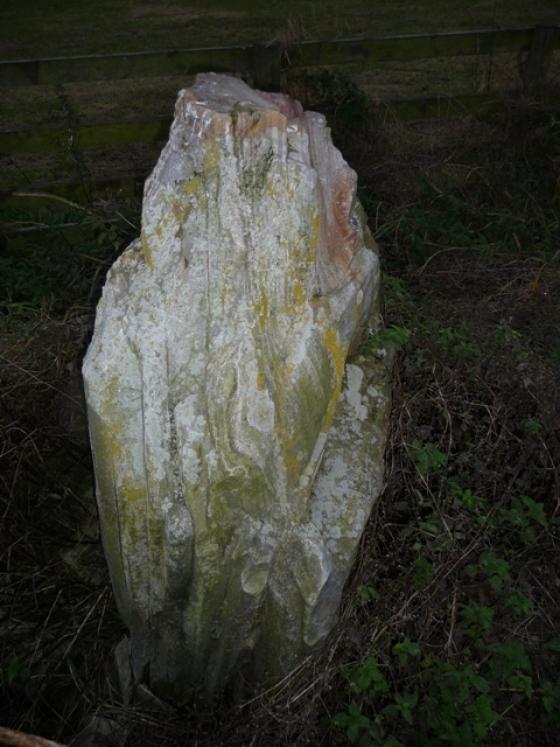Mr Coles records the details of these stones so carefully, and I love his bold drawings, which he must have enjoyed making. I think he’d be very sad to see two of the stones lying on the floor, and I do hope someone has put them back up again by now.
Upper Port, Castle Grant. – The Stones here stand on a level field nearly midway between Upper Port steadings and the Mill of Castle Grant, and about 1 1/2 miles distant on the N.E. from Grantown.
There are four Stones in all. I show them in a sketch-plan with their relative positions correctly given, but the interspaces are not to scale (See fig. 1.).
(a) The two South Stones. The East Stone stands 4 feet 3 inches in height, measured at the smooth, vertical, north side; but a long “foot” runs down at its S.E. angle, and if this represents the true base of the Stone, its height would be fully 5 feet. The basal girth is 9 feet 7 inches; the top is narrow and ridgy, and it appears to be composed of rough whinstone largely mixed with white quartz.
The companion Stone, standing nearly vertical 7 feet to the west, is of the same mineralogical composition, 4 feet 8 inches in height, with a rather flat top and a basal girth of only 4 feet 2 inches. In the view (fig. 2) these Stones are shown as seen from the west. This Stone is 117 yards Mag. S.20 degrees E from
(b) the Stone which stands next in order on the sketch-plan. It is of whinstone, with a pointed top, broadish sides, and a basal girth of 5 feet 7 inches. It is quite vertically set up.
(c) The last Stone of the group is of whinstone, somewhat tapering up from a base measuring 7 feet 7 inches to a “bevelled” top which is 5 feet 3 1/2 inches above the ground. Its broadest face is distant, nearly due west, 79 yards from Stone b.
It is impossible to even conjecture the meaning of the disposition of these four Stones at Upper Port, and there is no local information obtainable now regarding them.
The last two, so widely separated, are shown in the drawing (figs. 3 and 4) as seen from the south.
From ‘Report on Stone Circles Surveyed in the North-East of Scotland (Banffshire and Moray)..’ by Fred R Coles, in the Proceedings of the Society of Antiquaries of Scotland (February 11th 1907).

















































































